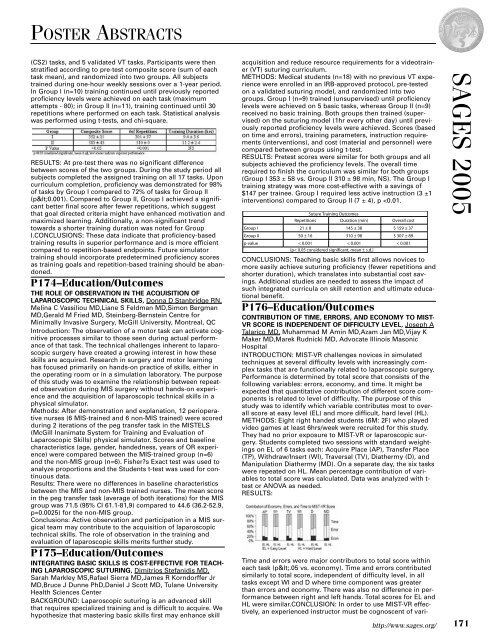2005 SAGES Abstracts
2005 SAGES Abstracts
2005 SAGES Abstracts
You also want an ePaper? Increase the reach of your titles
YUMPU automatically turns print PDFs into web optimized ePapers that Google loves.
POSTER ABSTRACTS<br />
(CS2) tasks, and 5 validated VT tasks. Participants were then<br />
stratified according to pre-test composite score (sum of each<br />
task mean), and randomized into two groups. All subjects<br />
trained during one-hour weekly sessions over a 1-year period.<br />
In Group I (n=10) training continued until previously reported<br />
proficiency levels were achieved on each task (maximum<br />
attempts - 80); in Group II (n=11), training continued until 30<br />
repetitions where performed on each task. Statistical analysis<br />
was performed using t-tests, and chi-square.<br />
RESULTS: At pre-test there was no significant difference<br />
between scores of the two groups. During the study period all<br />
subjects completed the assigned training on all 17 tasks. Upon<br />
curriculum completion, proficiency was demonstrated for 98%<br />
of tasks by Group I compared to 72% of tasks for Group II<br />
(p<0.001). Compared to Group II, Group I achieved a significant<br />
better final score after fewer repetitions, which suggest<br />
that goal directed criteria might have enhanced motivation and<br />
maximized learning. Additionally, a non-significant trend<br />
towards a shorter training duration was noted for Group<br />
I.CONCLUSIONS: These data indicate that proficiency-based<br />
training results in superior performance and is more efficient<br />
compared to repetition-based endpoints. Future simulator<br />
training should incorporate predetermined proficiency scores<br />
as training goals and repetition-based training should be abandoned.<br />
P174–Education/Outcomes<br />
THE ROLE OF OBSERVATION IN THE ACQUISITION OF<br />
LAPAROSCOPIC TECHNICAL SKILLS, Donna D Stanbridge RN,<br />
Melina C Vassiliou MD,Liane S Feldman MD,Simon Bergman<br />
MD,Gerald M Fried MD, Steinberg-Bernstein Centre for<br />
Minimally Invasive Surgery, McGill University, Montreal, QC<br />
Introduction: The observation of a motor task can activate cognitive<br />
processes similar to those seen during actual performance<br />
of that task. The technical challenges inherent to laparoscopic<br />
surgery have created a growing interest in how these<br />
skills are acquired. Research in surgery and motor learning<br />
has focused primarily on hands-on practice of skills, either in<br />
the operating room or in a simulation laboratory. The purpose<br />
of this study was to examine the relationship between repeated<br />
observation during MIS surgery without hands-on experience<br />
and the acquisition of laparoscopic technical skills in a<br />
physical simulator.<br />
Methods: After demonstration and explanation, 12 perioperative<br />
nurses (6 MIS-trained and 6 non-MIS trained) were scored<br />
during 2 iterations of the peg transfer task in the MISTELS<br />
(McGill Inanimate System for Training and Evaluation of<br />
Laparoscopic Skills) physical simulator. Scores and baseline<br />
characteristics (age, gender, handedness, years of OR experience)<br />
were compared between the MIS-trained group (n=6)<br />
and the non-MIS group (n=6). Fisher?s Exact test was used to<br />
analyze proportions and the Students t-test was used for continuous<br />
data.<br />
Results: There were no differences in baseline characteristics<br />
between the MIS and non-MIS trained nurses. The mean score<br />
in the peg transfer task (average of both iterations) for the MIS<br />
group was 71.5 (95% CI 61.1-81,9) compared to 44.6 (36.2-52.9,<br />
p=0.0025) for the non-MIS group.<br />
Conclusions: Active observation and participation in a MIS surgical<br />
team may contribute to the acquisition of laparoscopic<br />
technical skills. The role of observation in the training and<br />
evaluation of laparoscopic skills merits further study.<br />
P175–Education/Outcomes<br />
INTEGRATING BASIC SKILLS IS COST-EFFECTIVE FOR TEACH-<br />
ING LAPAROSCOPIC SUTURING, Dimitrios Stefanidis MD,<br />
Sarah Markley MS,Rafael Sierra MD,James R Korndorffer Jr<br />
MD,Bruce J Dunne PhD,Daniel J Scott MD, Tulane University<br />
Health Sciences Center<br />
BACKGROUND: Laparoscopic suturing is an advanced skill<br />
that requires specialized training and is difficult to acquire. We<br />
hypothesize that mastering basic skills first may enhance skill<br />
acquisition and reduce resource requirements for a videotrainer<br />
(VT) suturing curriculum.<br />
METHODS: Medical students (n=18) with no previous VT experience<br />
were enrolled in an IRB-approved protocol, pre-tested<br />
on a validated suturing model, and randomized into two<br />
groups. Group I (n=9) trained (unsupervised) until proficiency<br />
levels were achieved on 5 basic tasks, whereas Group II (n=9)<br />
received no basic training. Both groups then trained (supervised)<br />
on the suturing model (1hr every other day) until previously<br />
reported proficiency levels were achieved. Scores (based<br />
on time and errors), training parameters, instruction requirements<br />
(interventions), and cost (material and personnel) were<br />
compared between groups using t-test.<br />
RESULTS: Pretest scores were similar for both groups and all<br />
subjects achieved the proficiency levels. The overall time<br />
required to finish the curriculum was similar for both groups<br />
(Group I 353 ± 58 vs. Group II 310 ± 98 min, NS). The Group I<br />
training strategy was more cost-effective with a savings of<br />
$147 per trainee. Group I required less active instruction (3 ±1<br />
interventions) compared to Group II (7 ± 4), p
















